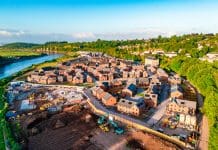The team at Buro Happold examine what is needed to answer the UK’s housing crisis- and how retrofitting can help make use of over one million empty homes
The UK has been wrestling with a housing crisis for years. Leading think tank Centre for Cities suggests that the UK is “missing” four million homes. This has more implications than are immediately conceived, such as impeded labour mobility and the increased likelihood of health issues for families living in substandard housing.
The long-term failure to supply sufficient homes at the rate needed sits at the heart of the problem. Addressing this has already been outlined as a priority for the new Labour government. In Rachel Reeves’ first speech as Chancellor, she cemented the government’s plan to fix Britain’s housing crisis, with the aim of building 1.5m new homes. A key part of this will be the overhaul of the UK’s “outdated” planning system, streamlining the process of building new, high-quality homes that are affordable.
However, volume and affordability are just some of the challenges the government must address in tackling the UK’s housing shortage. We’re firmly in an era of climate crisis, and this must influence the way we plan and design our cities and urban areas.
When we build new, build with climate resilience in mind
The government needs to ensure that climate resilience is at the forefront in planning new builds, and a priority for the private sector. For example, the UK government’s own estimates suggest the number of people in the UK significantly at risk of flooding is projected to increase 61% by 2050 under a warming scenario of 2°C. This could reach 118% in a high warming scenario of 4ºC. Future homes need to be protected against such risks, both in terms of location and design.
There is also the question of the contribution that these buildings themselves will have to our net-zero goals. Heating and powering buildings accounts for 30% of the UK’s total energy usage, so greening the use of energy in our homes will play a pivotal role in the UK’s efforts to hit net zero.
The Future Homes Standard (FHS), set to become mandatory in 2025, will ensure new homes built from 2025 will produce 75-80% less carbon emissions against a baseline year. It aims to achieve this through improving heating, hot water systems, reducing heat waste, introducing fabric improvements to reduce the need for heating, and replacing current technologies with low-carbon alternatives. The timing of this legislation is encouraging and will help ensure decarbonisation efforts are mandatory.
The value of retrofit in tackling the UK’s housing crisis
We must also interrogate the logic of focusing on new builds to reach this target. Building new is not the only option on the table. Recent data suggests there are roughly one million empty homes in the UK. This is a significant figure when put in the context of the four million “missing” homes that we need to create. Retrofitting empty homes and buildings, to make them fit for living in, must be a cornerstone of both public and private sector efforts. We need to see a clear, targeted policy focus from the government that urges the private sector to make use of these currently wasted assets.
Beyond making use of these neglected spaces, there are also a multitude of benefits to retrofitting. Firstly, it often makes economic sense. According to the Building Blocks manifesto, a national retrofit strategy could result in 550,000 new jobs by 2030, plus a £309bn boost to the economy. Effective retrofitting is also often cheaper than building new and reduces our carbon footprint. At Buro Happold, we have worked with C40 Cities to produce pathways for six cities – including Milan, Copenhagen and New York – that would help them make the case for clean construction. Emphasis on retrofit was a key part of this work. These pathways have proven to deliver long-term cost and climate savings by reducing carbon, waste, and the energy demand typically associated with new builds.
Retrofitting also helps to address the central concern around new builds of how this impacts the green belt. In order to unlock more land, Labour has pledged to rebrand some ‘lower-quality’ green belt land as ‘grey belt’ for new development. But the Green Belt serves several purposes – from inhibiting urban sprawl to supporting nature and biodiversity. Reducing the number of new builds by integrating more retrofits into their overall target, will take the pressure off the government’s search for land to build on.
Retrofitting capitalises on existing building stock
Placemaking is also a plus when we focus on upgrading and retrofitting existing buildings. Unlike new builds, retrofitting projects can be integrated with existing infrastructure, like transport and amenities. Finding locations for new builds that are well connected to existing infrastructure is a difficult task. This is of course what the government’s planning reforms intend to address, but retrofit again provides a convenient and immediate option that navigates this difficulty.
Considering all these benefits, it makes sense that local governments have begun exploring retrofitting projects alongside new builds. In the coming decade, for instance, Canning Town will transform three estates into a revitalised, community-led space. Alongside up to 1,750 new homes – of which at least 50% will be genuinely affordable – 322 existing homes will be retrofitted to provide high-quality homes which are economically viable and environmentally better than full demolition and new construction.
Labour’s prioritisation of new homes and planning reforms is ultimately welcome, but must be based on smart planning and policies that go beyond new builds. The government has the opportunity to link up a variety of problems by regenerating existing spaces and being selective over new build developments, an approach which can limit the impact on the green belt, revitalise communities and protect its people, while still meeting their goal. By building well and retrofitting right, the new Labour government can create a house building strategy that prioritises both people and planet.














